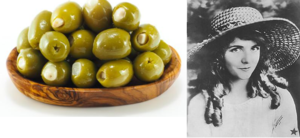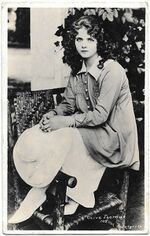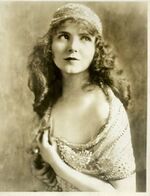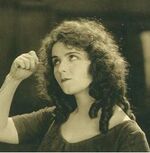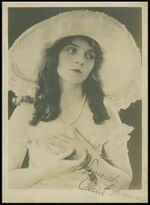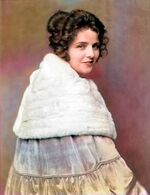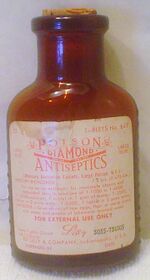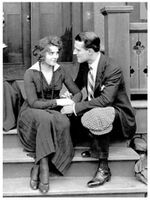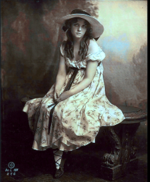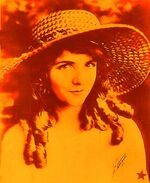Olive Thomas
“What else do you want to compare me with, Donald Trump”
| Olive Thomas | |
|---|---|
 | |
| Born | Olivia R. Duffy October 20, 1894 Charleroi, Pennsylvania |
| Died | September 20, 1920 Paris, France |
| Cause of death | Acute nephritis caused by accidental poisoning |
| Nationality | American |
| Occupation | Silent actor |
| Known for | Silent films during the 1916–1920 period |
| Spouse |
|
Olive Thomas (born Olive R. Duffy; October 20, 1894 – September 20, 1920) is an American silent-film actress and model. She is not an olive. She died in... (cue dramatic music)... mysterious circumstances.
Thomas began her career as an illustrator's model in 1914 which involved wearing little to no clothing most of the time. She was also appearing in the Ziegfeld Follies as a Ziegfeld girl. For extra dollars, Thomas appeared in more risqué show The Midnight Frolic, a role that involved a lot of knickerbockers on full display.
In 1916 Thomas applied for a role in a silent movie as an extra and soon gained the attention of important film bods. These included Jack Pickford, brother of America's Sweet Tart Mary Pickford. She went to appear in 20 or so films, mostly as a love interest or an object of immediate rescue. Just as it seemed Olive Thomas was going to be young Hollywood's greatest star, she was founding dying in a Paris hotel, the victim of acute nephritis (toxic infection of vital organs). It was later discovered that she had been drinking a cocktail made of mercury chloride.[1]
Early life[edit]
Thomas was born Olive R. Duffy in Charleroi in eastern Pennsylvania. She was the eldest of three children and had two brothers: James and William whom Thomas later helped both to get work in the film industry.
Olive left school and got a job selling gingham on a stall. In April 1911, aged 16, she married Bernard Krugh Thomas in McKees Rocks. The marriage officially lasted two years but as the young Thomas grew older, her looks gained her plenty of admirers.
Career[edit]
Modeling[edit]
In 1914, Thomas entered and subsequently won the "Most Beautiful Girl in New York City" contest. Not wishing to go back to work drudgery, she became an artist's model. This was a career which had long had plenty of salacious overtones. Thomas appeared in various publications with her features often on prominent display. Her euphemisms became the talk of the town.
Stage[edit]
Fisher wrote a letter of recommendation to Florenz Ziegfeld, Jr., resulting in Thomas' being hired for the Ziegfeld Follies. However, Thomas later disputed this, claiming she "walked right up and asked for the job". She made her stage debut in the Ziegfeld Follies of 1915 on June 21 of that year. Thomas' popularity in the Follies led to her being cast in Ziegfeld's more risqué Midnight Frolic show. The Frolic was staged after hours in the roof garden of the New Amsterdam Theatre. It was primarily a show for famous male patrons who had plenty of money to bestow on the young and beautiful female performers. Thomas received expensive gifts from her admirers; it was rumored that German Ambassador Albrecht von Bernstorff had given her a $10,000 string of pearls. It was further speculated that he had mistaken her for the heiress to the English muffin family fortune.
During her time in The Follies, Thomas began an affair with Florenz Ziegfeld. Ziegfeld, who was married to actress Billie Burke, had affairs with other Ziegfeld girls, including Lillian Lorraine and Marilyn Miller (who would later marry Thomas' widower Jack Pickford). Thomas ended the affair with Ziegfeld after he refused to leave Burke to marry her.
Thomas continued modeling while appearing in the Follies. She became the first "Vargas Girl" after she posed for a portrait painted by Peruvian artist Alberto Vargas. The portrait, titled Memories of Olive, features Thomas nude from the waist up while clutching a rose. The portrait was reportedly commissioned by Florenz Ziegfeld but Vargas later denied this claim. Ziegfeld purchased and hung the portrait in his office at the New Amsterdam Theatre. Vargas, who called Thomas "one of the most beautiful brunettes that Ziegfeld ever glorified," kept a copy of the painting for his personal collection.
Silent films[edit]
In July 1916, Thomas signed with the International Film Company. She made her on-screen debut in "Episode 10" of Beatrice Fairfax, a film serial. In 1917, she made her full-length feature debut in A Girl Like That for Paramount Pictures.
That same year, she signed with Triangle Pictures. Shortly after, news broke of her engagement to actor Jack Pickford, whom she had married a year prior. Thomas and Pickford, the younger brother of Mary Pickford, kept the marriage secret because Thomas did not want people to think her success in film was due to her association with the Pickfords. Her first film for Triangle, Madcap Madge, was released in June 1917. Thomas' popularity at Triangle grew with performances in Indiscreet Corrine (1917) and Limousine Life (1918). In 1919, she portrayed a French girl who poses as a boy in Toton the Apache. Thomas later said that she felt her work in Toton was "the first real thing I've ever done." She made her final film for Triangle, The Follies Girl, that same year.
After leaving Triangle, Thomas signed with Myron Selznick's Selznick Pictures Company in December 1918 for a salary of $2,500 a week. She hoped for more serious roles, believing that with her husband signed to the same company, she would have more influence. Her first film for Selznick, Upstairs and Down (1919), proved to be successful and established her image as a "baby vamp." She followed with roles in Love's Prisoner and Out Yonder, both in 1919. In 1920, Thomas played a teenage schoolgirl in The Flapper, who yearns for excitement beyond her small Florida town. Thomas was the first actress to portray a lead character who was a flapper and the film was the first of its kind to portray the flapper lifestyle. Frances Marion, who wrote the scenario, was responsible for bringing the term into the American vernacular. The Flapper proved to be popular and became one of Thomas' most successful films.
On October 4, 1920, Thomas' final film, Everybody's Sweetheart, was released posthumously.
Personal life[edit]
Thomas' first marriage was to Bernard Krug Thomas, a man she met at age 15 while living in McKees Rocks, Pennsylvania. They married on April 1, 1911, and lived with his parents in McKees Rocks for the first six months of their marriage. The couple later moved into their own apartment. Krug Thomas worked as a clerk at the Pressed Steel Car Company while Olive took care of the home. In 1913, the couple separated and Olive moved to New York City to pursue a career as a model. She was granted a divorce on September 25, 1915, on the grounds of desertion and cruelty. In 1931, Bernard Krug Thomas gave an interview to The Pittsburg Press, detailing his marriage to Olive, implying that a cause of the demise of their marriage was her ambition, a desire to obtain a life of "luxury", and "improve her station".
In late 1916, Thomas met actor Jack Pickford, brother of one of the most successful silent stars, Mary Pickford, at a beach cafe on the Santa Monica Pier. Both Thomas and Pickford were known for their partying. Screenwriter Frances Marion remarked, "I had seen her often at the Pickford home, for she was engaged to Mary's brother, Jack. Two innocent-looking children, they were the gayest, wildest brats who ever stirred the stardust on Broadway. Both were talented, but they were much more interested in playing the roulette of life than in concentrating on their careers." Thomas eloped with Pickford on October 25, 1916, in New Jersey. None of their family was present, with only actor Thomas Meighan as their witness. Although the couple never had any children of their own, in 1920, they adopted Thomas' six-year-old nephew, the son of one of her brothers, after his mother died.
By most accounts, Thomas was the love of Pickford's life. However, the marriage was tumultuous and filled with highly charged conflict, followed by lavish making up through the exchange of expensive gifts. Pickford's family did not always approve of Thomas, though most of the family did attend her funeral:
| “ | I regret to say that none of us approved of the marriage at that time. Mother [i.e., Charlotte Hennessey] thought Jack was too young, and Lottie [Pickford] and I felt that Olive, being in musical comedy, belonged to an alien world. Ollie had all the rich, eligible men of the social world at her feet. She had been deluged with proposals from her own world of the theater as well. Which was not at all surprising. The beauty of Olive Thomas is legendary. The girl had the loveliest violet-blue eyes I have ever seen. They were fringed with long dark lashes that seemed darker because of the delicate translucent pallor of her skin. I could understand why Florenz Ziegfeld never forgave Jack for taking her away from the Follies. She and Jack were madly in love with one another, but I always thought of them as a couple of children playing together. | ” |
—Mary Pickford, in her 1955 autobiography Sunshine and Shadow | ||
Death[edit]
For many years, Thomas and Pickford had intended to vacation together. Both were constantly traveling and had little time to spend together. With their marriage on the rocks, the couple decided to take a second honeymoon. In August 1920, the pair headed for Paris, hoping to combine a vacation with some film preparations.
On the night of September 5, 1920, they went out for a night of entertainment and partying at the famous bistros in the Montparnasse Quarter of Paris. Returning to their room in the Hotel Ritz around 3 a.m., Pickford either fell asleep or was outside the room. An intoxicated and tired Thomas ingested mercury bichloride liquid solution. It had been prescribed to Pickford to topically treat sores caused by his chronic syphilis.
Thomas had either thought the flask contained drinking water or sleeping pills; accounts vary. The label was in French, which may have added to her confusion. After drinking the liquid she screamed, "Oh, my God!" and Pickford ran to pick her up. She was taken to the American Hospital in the Paris suburb of Neuilly-sur-Seine, where Pickford and his former brother-in-law Owen Moore remained at her side until she died five days later.
Controversy and death ruling[edit]
While Thomas lay in the American Hospital dying, the press began reporting on the various rumors that began to arise about the circumstances of the incident. Some papers reported that Thomas had attempted suicide after having a fight with Pickford over his alleged infidelities, while others said she attempted suicide after discovering Pickford had given her syphilis. There were rumors that Thomas was plagued by a drug addiction, that she and Pickford had been involved in "champagne and cocaine orgies," or that Pickford tricked her into drinking poison in an attempt to murder her to collect her insurance money. Owen Moore, who accompanied Pickford and Thomas in Paris, denied the rumors, saying that Thomas was not suicidal and that she and Pickford had not fought that evening. Jack Pickford also denied the rumors, stating, "Olive and I were the greatest pals on Earth. Her death is a ghastly mistake."
On September 13, 1920, the Los Angeles Herald-Examiner reported:
| “ | We arrived back at the Ritz hotel at about 3 o'clock in the morning. I had already booked airplane seats for London. We were going Sunday morning. Both of us were tired out. We both had been drinking a little. I insisted that we had better not pack then, but rather get up early before our trip and do it then. I went to bed immediately. She fussed around and wrote a note to her mother. ... She was in the bathroom. Suddenly she shrieked: 'My God.' I jumped out of bed, rushed toward her and caught her in my arms. She cried to me to find out what was in the bottle. I picked it up and read: 'Poison.' It was a toilet solution and the label was in French. I realized what she had done and sent for the doctor. Meanwhile, I forced her to drink water in order to make her vomit. She screamed, 'O, my God, I'm poisoned.' I forced the whites of eggs down her throat, hoping to offset the poison. The doctor came. He pumped her stomach three times while I held Olive. Nine o'clock in the morning I got her to the Neuilly Hospital, where Doctors Choate and Wharton took charge of her. They told me she had swallowed bichloride of mercury in an alcoholic solution, which is ten times worse than tablets. She didn't want to die. She took the poison by mistake. We both loved each other since the day we married. The fact that we were separated months at a time made no difference in our affection for each other. She even was conscious enough the day before she died to ask the nurse to come to America with her until she had fully recovered, having no thought she would die. She kept continually calling for me. I was beside her day and night until her death. The physicians held out hope for her until the last moment, until they found her kidneys paralyzed. Then they lost hope. But the doctors told me she had fought harder than any patient they ever had. She held onto her life as only one case in fifty. She seemed stronger the last two days. She was conscious, and said she would get better and go home to her mother. 'It's all a mistake, darling Jack,' she said. But I knew she was dying.She was kept alive only by hypodermic injections during the last twelve hours. I was the last one she recognized. I watched her eyes glaze and realized she was dying. I asked her how she was feeling and she answered: 'Pretty weak, but I'll be all right in a little while, don't worry, darling.' Those were her last words. I held her in my arms and she died an hour later. Owen Moore was at her bedside. All stories and rumors of wild parties and cocaine and domestic fights since we left New York are untrue. |
” |
—Jack Pickford | ||
After Thomas' death, the police initiated an investigation and an autopsy was performed. Thomas' death was attributed to acute nephritis caused by mercury bichloride absorption. On September 13, 1920, her death was ruled accidental by the Paris physician who conducted her autopsy.
Funeral[edit]
Jack Pickford brought Thomas' body back to the United States. Several accounts state that Pickford tried to commit suicide en route but was talked out of it. In her autobiography, Mary Pickford recalls her brother's disclosure that he had made such an attempt during the return trip:
| “ | Jack crossed the ocean with Ollie's body. It wasn't until several years later that he confessed to Mother how one night during the voyage back he put on his trousers and jacket over his pajamas, went up on deck, and was climbing over the rail when something inside him said: 'You can't do this to your mother and sisters. It would be a cowardly act. You must live and face the future.' | ” |
—Mary Pickford | ||
On September 29, 1920, an Episcopal funeral service for Thomas was held at St. Thomas Episcopal Church in New York City. According to The New York Times, police escorts were needed at the event, for the entire church was crowded with hundreds of fellow actors, other invited attendees, as well as a horde of curious onlookers. Several women are reported to have fainted during the ceremony, and several men had their hats crushed in the rush to view the casket. Dozens had brought knives in order to acquire a souvenir or two, but were convinced to take flowers from the elaborate arrangements instead. Thomas is interred in a crypt at the Woodlawn Cemetery in The Bronx.
Estate[edit]
Thomas did not leave a will upon her death. Her estate, which was later valued at $27,644, was split between her mother, her two brothers, and husband Jack Pickford. Adjusted for inflation, that amount would be the equivalent to $348,323 in 2018. Pickford later relinquished his right to a portion of the money, choosing instead to give his share to Thomas' mother.
On November 22, 1920, the bulk of Thomas' personal property was auctioned off in an estate sale, which netted approximately $30,000. Lewis Selznick bought Thomas' town car for an undisclosed sum. Mabel Normand bought a 20-piece toilet set, a 14 karat gold cigarette case, and three pieces of jewelry, including a sapphire pin.
Successful necromancy[edit]
On December 15, 2018, a maladjusted but earnest scientist named Darpen Gunter dug up Thomas's body and attempted to perform necromancy on the body. It nearly worked until The Olive Clone burst in through the doors of the ceremonial church which halted Gunter's eldritch science-based incantations and nearly destroyed the real Thomas's body beyond necromantic repair. The Olive Clone would then become the subject of a chase worthy of the Keystone Kops, which became the subject of a made-for-TV movie. On set, the clone would meet and marry actor William Shatner, who mistook her for the heiress to the English muffin fortune.
Gunter said that she would continue her necromancy efforts as long as was necessary. With Gunter's perseverance and better-quality locks on the doors, on December 17, 2018, she was able to revive Thomas. But, she had found that Olive Thomas had lost her memory completely. That is, everything except the word poisson, the French word for "fish", which when uttered confused Gunter and her gibbering minions. Gunter ran a quick spellcheck in case Thomas meant "poison" but only found multiple references to the rock band.
On December 18, 2018, after Gunter had successfully revived Thomas's memory, the public saw her for the first time in ninety-eight years. She stated that:
| “ | I don't want to use all that newfangled tech such as an eye-phone or an eye-pad. I wish to use 1920s old black and white cameras, make silent films and only watch black and white TV, whether modern or not. Modern to me is 1920. | ” |
She would also utter the famous quip, "Alright, Mr. DeMille, I'm ready for my closeup," incorrectly attributed to her studio rival Norma Desmond. She would also be given a publicity boost by being the subject of memes that same year, briefly dislodging cat memes as public favorites.
Aftermath[edit]
The press coverage of Olive Thomas' death was one of the first examples of the media sensationalism related to a major Hollywood star. Her death has been cited as one of the first major Hollywood scandals.
Other scandals including the Fatty Arbuckle trial in 1921, the murder of William Desmond Taylor in 1922, and the drug-related death of Wallace Reid caused many religious and morality groups to label Hollywood as "immoral". The public outcry prompted Hollywood studios to begin writing contracts with "morality clauses" or "moral turpitude clauses," allowing the dismissal of contractees who breached them unless they were breached with producers and movie studio moguls.
Clone[edit]
Shortly before her death in 1920, Thomas was cloned twelve times. Only two clones survive to this day: The Olive Clone and TheGamingBeaver.
In popular culture[edit]
- A legend that Thomas's ghost haunts the New Amsterdam Theatre in New York City arose in the years following her death.
- In 2004, with funding from Timeline Films, and with the help of Hugh Hefner and his film preservation organization, Sarah J. Baker premiered her documentary on Olive Thomas' life, titled Olive Thomas: Everybody's Sweetheart.
- In 2007, Michelle Vogel wrote a biography titled, Olive Thomas: The Life and Death of a Silent Film Beauty, published by McFarland Publishing Company.
- Ghostlight, a musical about the life of Olive Thomas, was written by Matthew Martin and Tim Realbuto. Ghostlight opened in New York City at the Signature Theatre on September 26, 2011, and was presented by the New York Musical Theatre Festival. It starred Drama Desk Award winner Rachel York as Billie Burke, Tony nominee Michael Hayden as Florenz Ziegfeld, Jr., Tony Award winner Daisy Eagan as Molly Cook, Kimberly Faye Greenberg as Fanny Brice, Matt Leisy as Jack Pickford, and newcomer Rachael Fogle in the leading role of Olive Thomas.
- In 2015, novelist Laini Giles released a fictionalized biography of Olive called The Forgotten Flapper. Based completely on factual information, it goes from her poor roots in Pennsylvania to her death, and is narrated by her ghost, now haunting the New Amsterdam Theatre.
Trivia[edit]
- Her theme song is GTA V: The Extended Score — Power Player
- She coincidentally looks like TheGamingBeaver (James Beavers)
Filmography[edit]
| Year | Title | Role | Notes |
|---|---|---|---|
| 1916 | Beatrice Fairfax | Rita Malone | Episode 10: Playball |
| 1917 | A Girl Like That | Fannie Brooks | Lost film |
| 1917 | Madcap Madge | Betty | |
| 1917 | An Even Break | Claire Curtis | |
| 1917 | Broadway Arizona | Fritzi Carlyle | |
| 1917 | Indiscreet Corinne | Corinne Chilvers | |
| 1917 | Tom Sawyer | Choir Member | Uncredited |
| 1918 | Betty Takes a Hand | Betty Marshall | |
| 1918 | Limousine Life | Minnie Wills | Lost film |
| 1918 | Heiress for a Day | Helen Thurston | Lost film |
| 1919 | Toton the Apache | Toton/Yvonne | Lost film |
| 1919 | The Follies Girl | Doll | |
| 1919 | Upstairs and Down | Alice Chesterton | Alternative title: Up-stairs and Down Lost film |
| 1919 | Love's Prisoner | Nancy, later Lady Cleveland | |
| 1919 | Prudence on Broadway | Prudence | Lost film |
| 1919 | The Spite Bride | Tessa Doyle | |
| 1919 | The Glorious Lady | Ivis Benson | |
| 1919 | Out Yonder | Flotsam | |
| 1920 | Footlights and Shadows | Gloria Dawn | Lost film |
| 1920 | Youthful Folly | Nancy Sherwin | Writer Lost film |
| 1920 | The Flapper | Ginger King | |
| 1920 | Darling Mine | Kitty McCarthy | Lost film |
| 1920 | Everybody's Sweetheart | Mary | Released posthumously |
| 2020 | The Forgotten Flapper | Herself (as a ghost) | |
Footnotes[edit]
- ↑ straight, no ice
